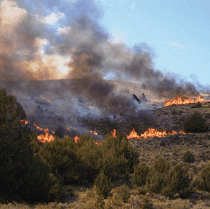Fuels & Fuel Treatments
View article.
This study found that Potential Wildfire Operational Delineations (PODs) were helpful for validating fuels treatment plans and supporting communication among agency staff, and with private landowners and collaborators. Challenges included lack of technical knowledge and skills, unclear leadership direction, potential misalignment with other forest management goals and community and agency buy-in to using PODs.
View brief.
Reducing PODs (potential operational delineations) to a network of suppression-focused fuel breaks may dilute the intent and diminish the richness of the framework. Using PODs and fuel breaks to perpetuate fire exclusion is not likely to be effective and may set us up for failure. In many forest types, we may need to rethink design of fuel breaks along POD boundaries to support expansion of proactive use of fire.
Save the date flyer.
In-person attendance is full, but stay tuned for some post-event resources and recordings.
View article.
Aims Invasion by annual grasses (IAGs) and concomitant increases in wildfire are impacting many drylands globally, and an understanding of factors that contribute to or detract from community resistance to IAGs is needed to inform postfire restoration interventions. Prefire vegetation condition is often unknown in rangelands but it likely affects variation in postfire invasion resistance across large burned scars. Whether satellite‐derived products like the Rangeland Analysis Platform (RAP) can fulfill prefire information needs and be used to parametrize models of fire recovery to inform postfire management of IAGs is a key question. Methods We used random forests to ask how IAG abundances in 669 field plots measured in the 2‐3 years following megafires in sagebrush steppe rangelands of western USA responded to RAP estimates of annual:perennial prefire vegetation cover, the effects of elevation, heat load, postfire treatments, soil moisture–temperature regimes, and land‐agency ratings of ecosystem resistance to invasion and resilience to disturbance. Results Postfire IAG cover measured in the field was % and RAP‐estimated prefire annual herbaceous cover was %. The random forest model had an R² of 0.36 and a root‐mean‐squared error (RMSE) of 4.41. Elevation, postfire herbicide treatment, and prefire estimates from RAP for the ratio of annual:perennial and shrub cover were the most important predictors of postfire IAG cover. Threshold‐like relationships between postfire IAG cover and the predictors indicate that maintaining annual:perennial cover below 0.4 and shrub cover below <10% prior to wildfire would decrease invasion, at low elevations below 1400 m above sea level. Conclusion Despite known differences between RAP and field‐based estimates of vegetation cover, RAP was still a useful predictor of variation in IAG abundances after fire. IAG management is oftentimes reactive, but our findings indicate impactful roles for more inclusively addressing the exotic annual community, and focusing on prefire maintenance of annual:perennial herbaceous and shrub cover at low elevations.
View article.
Effective wildlife management requires robust information regarding population status, habitat requirements, and likely responses to changing resource conditions. Single-species management may inadequately conserve communities and result in undesired effects to non-target species. Thus, management can benefit from understanding habitat relationships for multiple species. Pinyon pine and juniper are expanding into sagebrush-dominated ecosystems within North America and mechanical removal of these trees is frequently conducted to restore sagebrush ecosystems and recover greater sage-grouse. However, pinyon-juniper removal effects on non-target species are poorly understood, and changing pinyon-juniper woodland dynamics, climate, and anthropogenic development may obscure conservation priorities. To better predict responses to changing resource conditions, evaluate non-target effects of pinyon-juniper removal, prioritize species for conservation, and inform species recovery within pinyon-juniper and sagebrush ecosystems, we modeled population trends and density-habitat relationships for four sagebrush-associated, four pinyon-juniper-associated, and three generalist songbird species with respect to these ecosystems. We fit hierarchical population models to point count data collected throughout the western United States from 2008 to 2020. We found regional population changes for 10 of 11 species investigated; 6 of which increased in the highest elevation region of our study. Our models indicate pinyon-juniper removal will benefit Brewer’s sparrow, green-tailed towhee, and sage thrasher densities. Conversely, we predict largest negative effects of pinyon-juniper removal for species occupying early successional pinyon-juniper woodlands: Bewick’s wren, black-throated gray warblers, gray flycatcher, and juniper titmouse. Our results highlight the importance of considering effects to non-target species before implementing large-scale habitat manipulations. Our modeling framework can help prioritize species and regions for conservation action, infer effects of management interventions and a changing environment on wildlife, and help land managers balance habitat requirements across ecosystems.
View article.
Sagebrush shrublands in the Great Basin, USA, are experiencing widespread increases in wildfire size and area burned resulting in new policies and funding to implement fuel treatments. However, we lack the spatial data needed to optimize the types and locations of fuel treatments across large landscapes and mitigate fire risk. To address this, we developed treatment response groups (TRGs)—sagebrush and pinyon-juniper vegetation associations that differ in resilience to fire and resistance to annual grass invasion (R&R) and thus responses to fuel treatments.
Webinar recording.
Missoula Fire Sciences Lab Seminar Series
Nov 9 2023
Presenter: Dan Jimenez, RMRS Research Engineer
In the southwestern United States, non-native grass invasions have increased wildfire occurrence in deserts and the likelihood of fire spread to and from other biomes. Wildfires were historically small and infrequent in the warm deserts of western North America, with minimal impact on the desert vegetation. In recent decades, the fire regime has shifted with the spread of non-native grasses. Fires are increasingly burning large areas in desert habitats, largely driven by grassification, the physiognomic conversion of shrublands to grassland by non-native grass invasions. This conversion is especially concentrated at the upper elevational and northern latitudinal boundaries of the Sonoran Desert, which are transition zones to adjacent fire-prone biomes.
Catastrophic wildfires in the western United States pose significant risks to public health, infrastructure, and ecosystems. As these wildfires become more frequent, there is a growing need for a common methodology to identify suitable locations for prescribed burning aimed at mitigating future wildfire impacts to affected populations and ecosystems. This presentation explores the use of atmospheric chemistry transport modeling, satellite observations, and data from land managers to assess the effectiveness of prescribed burning interventions in reducing potential future wildfire smoke exposure. The presenter will offer lessons for states and rural environmental justice communities through a discussion on how implementing preventative prescribed burns in heavily forested areas such as Northern California and the Pacific Northwest may yield substantial net benefits for air quality across the entire western US, while similar interventions in other states would result in comparatively smaller impacts.
Webinar recording.
A practitioner-oriented overview of LANDFIRE with a focus on fuels and how they react to modeling techniques. The subject area of discussion will be the 2022 Cooks Peak fire located in northern New Mexico. This webinar will be technical in its application and may offer insights for both beginner and advanced LANDFIRE users.
Presenters: Tobin Smail, LANDFIRE Next Gen Fuels Lead, USFS Rocky Mountain Research Station Fire Modeling Institute; and Charley Martin, LANDFIRE Fuels, TSSC Contract USGS/KBR





